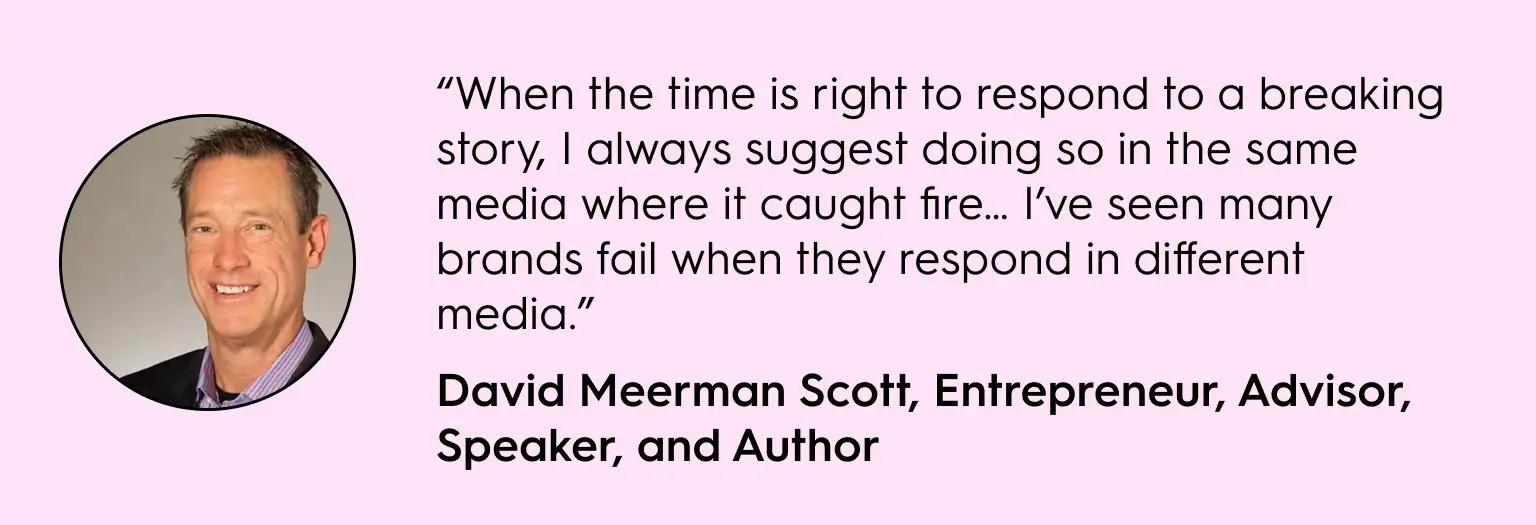What Happens When the Wrong Thing Goes Viral?
%20(1).webp)
Viral content has a habit of pretending it’s doing you a favor—until it shows up to your Monday stand-up with 800 angry quote tweets and a side of LinkedIn thinkpieces. And while your post “doing numbers” might sound good in Slack, those numbers start to look a lot like pitchforks when the wrong crowd shows up.
Most marketers secretly want to go viral. Let’s be honest—you don’t post at 9:47 a.m. with a CTA and hashtag combo because you don’t want engagement. But here’s the thing: viral content isn’t a win. It’s a high-stakes gamble with zero insurance.
The internet isn’t a fanbase—it’s a jury. And it doesn't care about your context.
So, before you find your brand in a group chat you were never meant to be in, let’s talk about what happens when the wrong thing catches fire.
“Good Content” Doesn’t Go Viral — Emotionally Charged Content Does
(And that’s where the problem starts)
The most viral content isn’t always the best—it’s the one that hits a nerve hard enough to twitch.
It’s not value that drives visibility. It’s reaction. Emotional pull. A triggered ego. A flash of outrage. A moment where someone thinks, “Oh, I have to send this to someone before I explode.”
Nearly 60% of all content sharing is ego-driven—not usefulness-driven, not brilliance-driven, not even relatability-driven. Ego.
%20(1).webp)
You post with your audience in mind. But what they share is filtered through how they want to look. Smarter. Funnier. More offended. More aware. Sometimes all at once. And that’s where even "good" campaigns spiral. Because emotion warps intent—and viral content doesn’t stay in the hands of the person who wrote it.
Anger travels six times faster than truth. Six.
According to a study from MIT, false news spreads six times faster than accurate stories—especially when the falsehood triggers outrage or fear.
Now apply that logic to a brand post. Not fake news, necessarily—but an out-of-context caption, a poorly timed joke, or a “bold stance” nobody asked for.
The problem isn’t always your idea. It’s that virality doesn’t reward context. It rewards friction. That’s why your PR-approved carousel is ignored while a misread tweet trends by lunchtime.
So no, brands aren't trending because their call-to-action was well-written. They're trending because they accidentally insulted three subcultures, one diaspora, and an entire side of the internet they didn’t know existed.
This is why risk management should happen before the posting party starts.
If your team’s definition of “review” is checking spelling and hashtags, good luck. You don’t prevent wrong viral content by being fast. You do it by being surgical. Thoughtful. Skeptical, even.
Because viral content risk management isn’t about being safe. It’s about being aware of what can happen when your post stops being yours.
We’re not saying stop being bold. Just stop equating “clever” with “cleared.” Stop assuming your intent will survive 7 million impressions without a scratch.
This is where real approval workflows come in. Not the “I skimmed it on my phone in line at Pret” kind. Actual structured reviews. Multiple pairs of eyes. Smart, logged feedback.
The kind ZoomSphere enables without letting your calendar fall apart.
When Brands Go Viral for the Worst Reason — The "OH NO" Hall of Fame
When your post isn’t celebrated—it’s circled for tearing apart
Let’s call this what it is: a brand crisis viral post. This isn’t creativity rewarded—it’s a public execution. Scroll-snack horror that empties shelves or splits stock prices by the billions. And yes, it’s happening more than you'd like to admit.
Bud Light: The Billion-Dollar Boomerang
A partnership that looked progressive turned political lightning. TikTok influencer Dylan Mulvaney’s collab sparked a conservative backlash so huge that Bud Light lost $26 billion in market value, slipped to fourth place in weekly beer rankings, saw U.S. revenue drop 10.5% YoY, and cratered sales by up to 30% in some weeks
This was a viral content example that crashed the top-selling beer in America.
Balenciaga’s Burn-and-Boycott Boom
An ad misstep involving kids and bondage accessories didn’t just generate awkward silence—it sparked the #burnBalenciaga movement with 300 million+ TikTok views, vandalized physical stores, and triggered global boycotts. This is a social media disaster story that dented trust faster than any quarterly earnings report.
Domino’s “Snot Pizza” Nightmare
In 2009, a grotesque prank video of employees contaminating sandwiches went worldwide. Local sales plunged by 50% within a week, dozens lost jobs, and the franchise shut down. Their CEO went on YouTube—on camera, apologizing—like he’d been kidnapped.
Yep. That ended up in a worst-case “viral posts gone wrong” trend.
What separates these is what follows the spark
Every single one of these cases follows the pattern:
- A single content moment
- Misread or mismanaged context
- People latch on and run—hard
These are viral mistake case studies that teach one brutal truth: your content can fracture faster than your crisis plan can activate.
Why we need to talk prevention, not performance
You can’t swat a viral grenade off the brand trench once it’s live. These episodes show how viral posts gone wrong don’t wait for approval—they auto-launch, get remixed, then they spread—fast.
That’s why preventing wrong viral content needs more than a checkbox. You need structure. And yes, it’s possible to chase traction without blowing up trust.
What Actually Breaks When You Go Viral for the Wrong Reason?
Your approval flow was the first thing to crack.
When viral content backfires, the platform’s not broken. The public isn’t overreacting. The real mess is behind the scenes. It’s the internal gears—the ones you swore were “tight”—grinding into smoke.
We’re talking operational failure in four swift layers.
Content Review: “I thought someone checked it.”
This is the first domino. The “yeah, looks good” that skips five eyes and sails right past formal approval. No one flags the half-baked meme. Everyone assumes someone else did.
But your audience doesn’t care if the wrong post came from an intern or an exec. It’s live. It’s yours.
ZoomSphere’s Scheduler doesn’t care if you're running late. It enforces content deadlines. So the pressure to “just post it” isn’t even part of the equation.
Context Filter: “Did nobody ask the basic question?”
No one paused to ask: “Is this the wrong joke… on the wrong day… during the wrong news cycle?” Maybe your copywriter’s joke was clever on Monday. By Thursday, it’s insensitive. Or worse, it’s tone-deaf and auto-published.
You don’t need twenty approvals. You need one person brave enough to say, “This headline will get us burned.”
ZoomSphere’s Workflow Manager doesn’t let things go live until they’ve passed every checkpoint. And you can tag specific people to weigh in—so “I didn’t know it went up” stops being a viable excuse.
Platform Mismatch: The post was good… somewhere else.
Posting a TikTok-sounding caption on LinkedIn isn’t edgy. It’s confusing. Context mismatch is how a well-meaning campaign ends up on “brands behaving badly” threads.
Your content might be solid. But tone is platform-specific. And when tone crashes the wrong feed, you’ve built a viral content damage control case study in real-time.
Real-Time Monitoring: “Wait—why are we trending at 2 AM?”
Most brands don’t get canceled. They get blindsided. A post you thought was doing “meh” wakes up on Reddit, gains teeth on X, and by morning, the CEO’s doing breath work in a stairwell.
If you’re still checking engagement manually, you’re late. ZoomSphere’s analytics flag when something’s performing oddly—before it becomes performative outrage.
What breaks isn’t the content—it’s the pipeline
You don’t end up in a brand crisis because of a post. You end up there because you had no brakes.
The idea probably came from someone clever.
The execution was likely rushed.
The review? Assumed.
The reaction? Missed.
The fix is better systems. And viral content risk management isn’t a warning sign. It’s a survival tool.
With ZoomSphere, you don’t have to guess if something got signed off. You don’t wonder if someone forgot to loop in legal. You don’t wait until trending to realize you’ve detonated your brand.
{{cta-component}}
You lock your flow before the content ever gets out.
Because when the wrong thing goes viral, it's never just the audience that breaks. It's your internal chain of command.
Set approvals. Enforce accountability. And for the love of credibility—stop assuming the internet will give you the benefit of the doubt. It won’t.
Why Apologies Don’t Work Like You Think They Do
The apology never travels as far as the mistake.
You already know this. But on average, apology posts get one-third the engagement of the viral mistake that triggered them. That’s according to data collected from multiple brand crises across social platforms.
You’re no longer the narrator. The audience has the mic. And the replies. And the screenshots. And the receipts.
When PR polish feels like a slap
There’s a reason no one wants to see “We’re sorry if you were offended.” It’s not just tone-deaf—it’s gasoline. Because in moments of viral backlash, your audience doesn’t want neutral. They want:
- Accountability (someone named, not “the team”)
- Clarity (what exactly went wrong)
- Change (not a vague promise to “do better”)
- Empathy (without the legalese)
A viral backlash strategy that defaults to templates and legal shielding doesn’t calm people—it confirms their suspicions.
What to freeze, what to fix
If your scheduled meme is 3 minutes away from going live while your brand is trending for being wildly offensive… pause the damn queue.
Here’s what the best crisis operators do immediately:
1. Pause all outbound content
Not later. Not after the meeting. Now. A stray joke or an unrelated promo while you’re being roasted is like showing up to a funeral in neon crocs. It screams “we’re not listening.”
%20(1).webp)
2. Switch on sentiment tracking
Engagement isn’t the same as approval. If the spike in comments is 90% sarcastic, you’re not gaining traction—you’re collecting memes you don’t want. Sentiment monitoring flags those shifts before they spiral into full-blown brand damage.
3. Change tone immediately
Scheduled sarcasm, dry wit, and cheeky emojis? Cancel them. You don’t need to go full grayscale, but you need tone that reads as aware, not robotic. If you can’t adjust tone mid-week, your calendar’s running you—not the other way around.
You’re not “in a crisis.” You’re under review.
Every reply is a little audit. Every repost is a public reminder of how your brand behaves when things get uncomfortable. You don’t get graded on how bad the mistake was. You get graded on how human your response is.
Knowing how to recover from viral mistake moments means recognizing they’re not PR problems. They’re perception control problems. And in 2025, perception spreads faster than you do.
So yeah—delete if needed. Apologize like a person. Ditch the templated apologies. And for the love of brand survival, don’t “just keep posting.” That never ends well.
Let the algorithm cool down. Then respond with something that doesn’t reek of damage control. Because if you’re not leading the narrative, your audience will.
How to Bulletproof Your Brand (Without Becoming Boring)
Let’s be clear—what gets you in trouble isn’t your content. It’s the process that let it slip through at 2AM without a second set of eyes and a working sense of risk.
There’s a difference between being edgy and being reckless. Most viral backfires? Not about being controversial. They’re about being careless. And preventable.
So, no—you don’t need to neuter your brand voice. You just need to stop trusting approval workflows that have all the structural integrity of a group chat.
Give Your Team a Damn Safety Net
Nobody wants to be the marketer who thought a post was greenlit… only to watch it detonate on TikTok before lunch. “I thought you saw it” shouldn’t be the last words before a reputation spiral.
Use approval-based scheduling. It’s insurance.
That means no post gets published without routing through whoever actually signs the legal checks—or the cultural ones.
Because if interns are still pushing brand tweets at midnight on their phones, you have a ticking headline.
{{form-component}}
Red Flags Shouldn’t Be Retrospective
You know what topics ignite the pitchforks—politics, religion, gender, race, violence, trauma.
So why are they getting casually slipped into copy without a single checkpoint?
Set up Red Flag Keywords. Literally. Inside approval workflows, mark terms that raise reputational risk. Flag them. Route them to legal or your most unflinchingly honest person. Someone who isn’t afraid to say, “That phrasing feels like a lawsuit.”
Because you don’t get to plead innocence after it hits 40 million views. You get to deal with consequences.
Volatility ≠ Virality
If your brand has ever gone viral and you don’t know why, you’re not lucky—you’re at risk.
ZoomSphere’s post tracking helps teams detect volatility patterns before they become full-blown disasters.
This Isn’t About Playing It Safe. It’s About Playing It Smart.
Every brand loves to talk about their personality. Until their “personality” triggers a boycott.
Want to prevent wrong viral content from tanking your quarter? Stop crossing your fingers. Start building workflows with teeth.
Put process where panic used to live.
In Case of Viral Meltdown: Your Brand’s Go-Bag Checklist
When it goes sideways—don’t scramble. Respond. Fast. And smart.
Every second counts in a negative viral campaign. A misstep that spirals becomes a social media disaster story in hours—and if you're fumbling, expect that crisis narrative to go viral faster than your last meme failed.
1. Pause All Scheduled Posts—Today.
When whispers become roars, take a breather. This isn’t overreacting—it’s buying a minute to think, regroup, and protect your brand’s sanity. Because another unrelated post during a meltdown is how things go from bad to WTF.
2. Respond In‑Platform
As David Meerman Scott says:

Don’t paste boilerplate across channels. If it's on X, post on X. If it’s a video, make a video. Context is everything. This isn’t PR theater—it’s accountability.
3. Don’t Delete Unless Legally Required.
Deleting a viral mistake is like swiping away a lie detector test—without explanation, it just looks dodgy. Unless you're forced—by court or code—you don’t get to vanish. You clarify. You respond.
4. Soften the Next Week’s Calendar.
Immediately lock down next week’s content. Swap out planned sass for safe service updates. A single tone shift reassures your audience—and gives your team time to cool off. This pivot signals you’re listening. And that you’re still human.
5. Debrief
Use the internal Notes feature like a crisis journal. Log what went wrong, who woke up when, and how the team responded. This internal archive is your post-crisis roadmap—and the source of your next viral backlash strategy.
6. Analyze Post-Mortem Data
After the dust settles, check analytics to understand what triggered the spike. Was it a phrase? A platform? A misread tone? Map out volatility peaks. Review them. Learn from them. Then build a targeted viral content risk management playbook around it.
Virality Doesn’t Build Your Brand—Control Does
Viral content is great—until it isn’t. One day it gets you applause; the next, you’re writing apology drafts with four people and a legal intern in the room. And the wildest part is… most brands don’t even know they’re stepping on a landmine until it’s already trending.
Because viral content doesn’t care how thoughtful your campaign was. It doesn’t care that your intern “meant well.” It just cares that it can move fast, cause a stir, and stay screenshot-friendly. And if your team doesn’t have built-in brakes—good luck catching it once it’s live.
That’s where systems matter more than charm. When posts don’t sneak through. When approvals are real, not “yeah sure, looks fine.” When someone actually checks what’s queued before it queues you.
ZoomSphere is here for your thresholds. Workflow rules that make approval more than a suggestion. A scheduler that doesn’t publish unless the green light is real.
Control isn’t glamorous. But it’s what keeps your brand from becoming this week’s trending regret.
Let the other guys chase clout. You’ll settle for stability—and a clean inbox on Monday.












Heading 1
Heading 2
Heading 3
Heading 4
Heading 5
Heading 6
Lorem ipsum dolor sit amet, consectetur adipiscing elit, sed do eiusmod tempor incididunt ut labore et dolore magna aliqua. Ut enim ad minim veniam, quis nostrud exercitation ullamco laboris nisi ut aliquip ex ea commodo consequat. Duis aute irure dolor in reprehenderit in voluptate velit esse cillum dolore eu fugiat nulla pariatur.
Block quote
Ordered list

- Item 1
- Item 2
- Item 3
Unordered list
- Item A
- Item B
- Item C
Bold text
Emphasis
Superscript
Subscript



.webp)


%20(1).webp)
%20(1).webp)
%20(1).webp)

